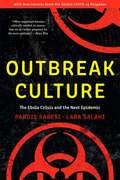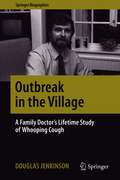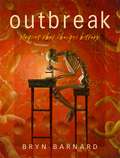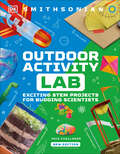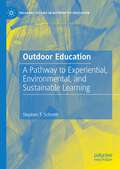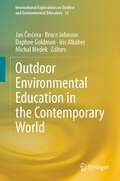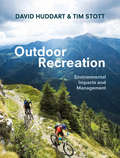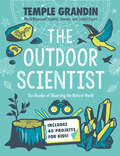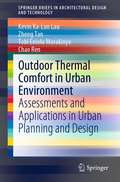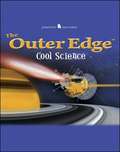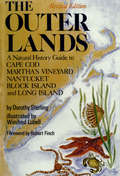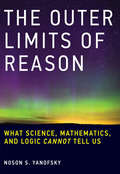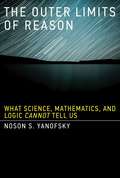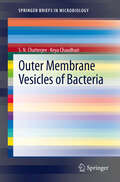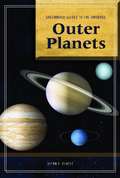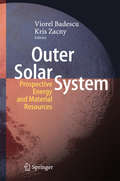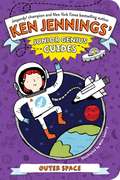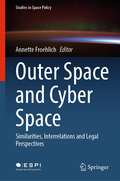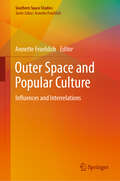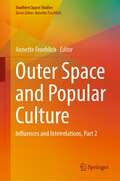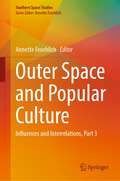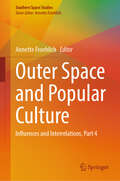- Table View
- List View
Outbreak!: Investigations In Epidemiology
by Russell G. WrightHere is a new module in the Event-Based Science series. In Outbreak!, students work together to discover the identity of a mysterious disease spreading through their community. There are hands-on activities, interviews with professionals, and interdisciplinary activities to guide students.
Outbreak Culture: The Ebola Crisis and the Next Epidemic, With a New Preface and Epilogue
by Pardis Sabeti Lara SalahiA Choice Outstanding Academic Title of the Year “A critical, poignant postmortem of the epidemic.” —Washington Post “Forceful and instructive…Sabeti and Salahi uncover competition, sabotage, fear, blame, and disorganization bordering on chaos, features that are seen in just about any lethal epidemic.” —Paul Farmer, cofounder of Partners in Health “The central theme of the book…is that common threads of dysfunction run through responses to epidemics…The power of Outbreak Culture is its universality.” —Nature “Sabeti and Salahi present a wealth of evidence supporting the imperative that outbreak response must operate in a coordinated, real-time manner.” —Science As we saw with the Ebola outbreak—and the disastrous early handling of the COVID-19 coronavirus pandemic—a lack of preparedness, delays, and system-wide problems with the distribution of critical medical supplies can have deadly consequences. Yet after every outbreak, the systems put in place to coordinate emergency responses are generally dismantled. One of America’s top biomedical researchers, Dr. Pardis Sabeti, and her Pulitzer Prize–winning collaborator, Lara Salahi, argue that these problems are built into the ecosystem of our emergency responses. With an understanding of the path of disease and insight into political psychology, they show how secrecy, competition, and poor coordination plague nearly every major public health crisis and reveal how much more could be done to safeguard the well-being of caregivers, patients, and vulnerable communities. A work of fearless integrity and unassailable authority, Outbreak Culture seeks to ensure that we make some urgently needed changes before the next pandemic.
Outbreak in the Village: A Family Doctor's Lifetime Study of Whooping Cough (Springer Biographies)
by Douglas JenkinsonOutbreak in the Village is a fascinating account of the personal and professional journey of Dr. Doug Jenkinson, physician and researcher. Over the course of four decades in practice, Jenkinson traces the reemergence of whooping cough in the developed world, using his practice in the idyllic English countryside as a clinical control group. Keeping meticulous notes and indulging an itch to investigate, he explores one of history's most enigmatic and pervasive diseases. Jenkinson relates the tale of his life's work amid winsome anecdotes, relevant history, and practical advice. Told in an amiable, engaging voice with an expert balance of levity and earnestness, this story will charm casual readers interested in medical history and memoir, as well as doctors and researchers who identify with the experiences and may benefit from the research and techniques employed. Readers will find themselves in the examination room beside Jenkinson as the investigation unfolds, learning about the nature of the illness and the sweeping detrimental effects of an anti-vaccination campaign. An intriguing memoir about a mysterious illness, a public health failure, and one doctor's quest for clarity, Outbreak in the Village is a tale of perseverance and objectivity sure to delight and inform.
Outbreak! Plagues That Changed History
by Bryn BarnardDid the Black Death destroy the feudal system? Did cholera pave the way for modern Manhattan? Did yellow fever help end the slave trade? Remarkably, the answer to all of these questions is yes. Time and again, diseases have impacted the course of human history in surprisingly powerful ways. From influenza to small pox, from tuberculosis to yellow fever, Bryn Barnard describes the symptoms and paths of the world's worst diseases-and how the epidemics they spawned have changed history forever.Highlighted with vivid and meticulously researched illustrations, Outbreak is a fascinating look at the hidden world of microbes-and how this world shapes human destiny every day.From the Hardcover edition.
Outdoor Activity Lab 2nd Edition (DK Activity Lab)
by Jack ChallonerWith a foreword by Robert Winston, this fun, fact-filled book is brimming with exciting outdoor experiments to help budding boffins explore the science in their own surroundings.Using easy-to-find household items, you can make giant bubbles to reveal how surface tension works, construct a water rocket and blast it skyward to learn about Newton's law of physics, discover how mushrooms grow by cultivating mycelium, and make your own barometer to measure atmospheric pressure ... and much more!Great photography, succinct step-by-step instructions, and rigorous attention to detail will make young scientists excited from the get-go. There is a clear How it works explanation for each project, revealing the fascinating science behind it, along with real-world examples that show everyday science in action.With 25 amazing projects to inspire young scientists and outdoor enthusiasts, Outdoor Activity Lab takes readers out of the house on a journey to better understand their world—perfect for every young scientist curious about the world.
Outdoor Education: A Pathway to Experiential, Environmental, and Sustainable Learning (Palgrave Studies in Alternative Education)
by Stephen T. SchrothThis book explores the phenomenon of outdoor education, an approach that permits children from all backgrounds to explore environmental, sustainability, and other issues facing them and their communities. Organized around both the conceptual and the practical issues facing school leaders interested in outdoor education, the book provides a wealth of resources for those interested in implementing outdoor education in their schools or classrooms. Infinitely flexible, outdoor education provides a lens through which teachers may explore any content area with any age group of children. Providing readers with both the theoretical underpinnings that support place-based curriculum as well as practical ways to implement an outdoor education program, the book also provides seven case studies that examine the issues facing school leaders desiring to make such a change. Outdoor Education: A Pathway to Experiential, Environmental, and Sustainable Learning guides those interested in exploring outdoor education through the curricular, instructional, and policy considerations needed to accomplish this goal.
Outdoor Environmental Education in the Contemporary World (International Explorations in Outdoor and Environmental Education #12)
by Jan Činčera Bruce Johnson Daphne Goldman Iris Alkaher Michal MedekThis edited volume explores the role of outdoor environmental education in the contemporary society. It identifies some of the opportunities and challenges of this educational area, particularly in the growing digitalization of the contemporary society and the distancing between people and nature. Furthermore, it seeks to answer why outdoor environmental education is essential for developing students’ environmental citizenship competencies or developing their relationship with nature. The book also introduces the various approaches existing in the field, discusses their relevance, and highlights their unique features. The book finishes with an overview of the practice of outdoor environmental education in selected countries from North America, Europe, and Asia.
Outdoor Recreation: Environmental Impacts and Management
by David Huddart Tim StottThis textbook presents a comprehensive overview of the environmental impacts of various types of outdoor recreation, and how these can be best managed. As a field of study, recreational ecology is both multidisciplinary and interdisciplinary, and the authors seek to develop a deeper understanding of both the role and function of the factors that influence visitor numbers and their impact. An accessible and comprehensive textbook, it features numerous types of outdoor recreational activities including hill walking, rock climbing, mountain marathons, skiing, scuba diving and more.Drawn from several global case studies, the authors estimate the current and future numbers involved in outdoor recreation, and how best these numbers can be managed. Effective visitor impact management actions arise from collaboration between recreation ecologists, social scientists, experienced recreation managers, recreation stakeholders and the recreationalists themselves: as such, this book will be multi-disciplinary in scope. This practical and engaging textbook will be invaluable to students and scholars of outdoor recreation and adventure tourism as well as practitioners and managers working in the field.
The Outdoor Scientist: The Wonder of Observing the Natural World
by Temple GrandinFrom New York Times bestselling author and world-renowned scientist and autism spokesperson Temple Grandin comes a book about exploring the world around us, asking questions, and making sense of what we see--with 40 fun outdoor activities that promote independent thinking, which kids can enjoy all year round!What are the aerodynamics of skipping stones or the physics of making sandcastles? Do birds use GPS to navigate their migratory routes? In this book, Dr. Temple Grandin, an inventor and world-renowned scientist, introduces readers to geologists, astrophysicists, oceanographers, and many other scientists who unlock the wonders of the natural world. She shares her childhood experiences and observations, whether on the beach, in the woods, working with horses, or gazing up at the night sky. This book explores all areas of nature and gives readers the tools to discover even more on their own.With forty projects to give readers a deeper understanding of the world around them, from the depths of space to their own backyard, this is a perfect read for budding scientists, inventors, and creators! Praise for The Outdoor Scientist:"Grandin&’s words are a rallying cry for budding scientists and she serves as a role model for young readers with autism. This is an important STEM and STEAM resource for every collection." --School Library Journal "The book is chock-full of information . . . the kind a nature-loving child will be thrilled to discover. An invitation to young readers to observe, enjoy, and learn about the world around us all." --Kirkus Reviews
Outdoor Thermal Comfort in Urban Environment: Assessments and Applications in Urban Planning and Design (SpringerBriefs in Architectural Design and Technology)
by Kevin Ka-Lun Lau Zheng Tan Tobi Eniolu Morakinyo Chao RenThis book highlights the importance of outdoor thermal comfort for improving urban living quality in the context of urban planning and urban geometry design. It introduces readers to a range of assessment methods and applications of outdoor thermal comfort and addresses urban geometry and thermal environment at the neighbourhood scale using real-world examples and parametric studies. In addition, the subjective evaluations by urban dwellers and numerical modelling tools introduced in this book provide not only a comprehensive assessment of outdoor thermal comfort but also an integrated approach to using thermal comfort indicators as a standard in high-density cities. Given its scope, the book offers a valuable guide for urban climate researchers, urban planners, and designers, and policymakers pursuing more liveable urban environments.
The Outer Edge: Cool Science
by Henry Billings Melissa BillingsEnergize low-level readers with the series based on amazing, true stories. Lower readability series joins the Wild Side/Critical Reading family. Emphasis is on reading nonfiction. Critical thinking questions prepare students for state and national tests. The Outer Edge builds on the success of Jamestown's popular Wild Side and Critical Reading series, enticing struggling readers with amazing, strange, and unbelievable nonfiction, now at a lower reading level. Comprehension questions reinforce literal understanding, while critical thinking questions encourage students to speculate about author's purpose, make inferences,identify cause and effect, support conclusions, and make predictions. Best of all, this program is designed to reinforce state reading standards for your most struggling readers. Reading Level 2-4. Interest Level 6-12.
The Outer Edge: Classic Investigations of the Paranormal
by Tom Genoni Barry Karr Joe NiekellInvestigations into celestial portents, extraterrestrials, fortune telling, and visions of death.
The Outer Lands: A Natural History Guide to Cape Cod, Martha's Vineyard, Nantucket, Block Island, and Long Island
by Dorothy Sterling Robert Finch Winifred LubellDid you know that horseshoe crabs have been around for 200 million years? That mussels "spin" long anchor lines and climb steep slopes with them? Do you know what a "Beetlebung" tree is? This is all part of Dorothy Sterling's fascinating description of The Outer Lands, and the plants and animals that inhabit this peninsula and chain of islands along our New England coast.
The Outer Limits of Reason: What Science, Mathematics, and Logic Cannot Tell Us
by Noson S. YanofskyAn exploration of the scientific limits of knowledge that challenges our deep-seated beliefs about our universe, our rationality, and ourselves.Many books explain what is known about the universe. This book investigates what cannot be known. Rather than exploring the amazing facts that science, mathematics, and reason have revealed to us, this work studies what science, mathematics, and reason tell us cannot be revealed. In The Outer Limits of Reason, Noson Yanofsky considers what cannot be predicted, described, or known, and what will never be understood. He discusses the limitations of computers, physics, logic, and our own thought processes.Yanofsky describes simple tasks that would take computers trillions of centuries to complete and other problems that computers can never solve; perfectly formed English sentences that make no sense; different levels of infinity; the bizarre world of the quantum; the relevance of relativity theory; the causes of chaos theory; math problems that cannot be solved by normal means; and statements that are true but cannot be proven. He explains the limitations of our intuitions about the world—our ideas about space, time, and motion, and the complex relationship between the knower and the known.Moving from the concrete to the abstract, from problems of everyday language to straightforward philosophical questions to the formalities of physics and mathematics, Yanofsky demonstrates a myriad of unsolvable problems and paradoxes. Exploring the various limitations of our knowledge, he shows that many of these limitations have a similar pattern and that by investigating these patterns, we can better understand the structure and limitations of reason itself. Yanofsky even attempts to look beyond the borders of reason to see what, if anything, is out there.
The Outer Limits of Reason: What Science, Mathematics, and Logic Cannot Tell Us
by Noson S. YanofskyMany books explain what is known about the universe. This book investigates what cannot be known. Rather than exploring the amazing facts that science, mathematics, and reason have revealed to us, this work studies what science, mathematics, and reason tell us cannot be revealed. In "The Outer Limits of Reason," Noson Yanofsky considers what cannot be predicted, described, or known, and what will never be understood. He discusses the limitations of computers, physics, logic, and our own thought processes. Yanofsky describes simple tasks that would take computers trillions of centuries to complete and other problems that computers can never solve; perfectly formed English sentences that make no sense; different levels of infinity; the bizarre world of the quantum; the relevance of relativity theory; the causes of chaos theory; math problems that cannot be solved by normal means; and statements that are true but cannot be proven. He explains the limitations of our intuitions about the world -- our ideas about space, time, and motion, and the complex relationship between the knower and the known. Moving from the concrete to the abstract, from problems of everyday language to straightforward philosophical questions to the formalities of physics and mathematics, Yanofsky demonstrates a myriad of unsolvable problems and paradoxes. Exploring the various limitations of our knowledge, he shows that many of these limitations have a similar pattern and that by investigating these patterns, we can better understand the structure and limitations of reason itself. Yanofsky even attempts to look beyond the borders of reason to see what, if anything, is out there.
Outer Membrane Vesicles of Bacteria
by Keya Chaudhuri S. N. ChatterjeeThis book provides a detailed account of the physico-chemical properties and biological functions of the outer membrane vesicles (OMVs) of different pathogenic and non-pathogenic Gram-negative bacteria. It also includes an authentic record of the first systematic study that discovered the mechanism of OMV formation by a pathogen, Vibrio cholerae, and proposed that the process represented a novel secretory activity of bacteria. Furthermore, the authors present clinical and laboratory data on the use of OMVs as immunogens, as effective and licensed vaccines against Neisseria meningitidis serogroup B infections and on the development of more effective vaccines against other human and animal pathogens including Vibrio cholerae. This volume thus bears witness to the emerging revolution in the field of vaccines against pathogens and closes with a discussion of open questions and future research on OMVs.
The Outer Planets: Uranus, Neptune and Pluto (Planet Guides)
by Duncan BrewerThis valuable beginners guide to the outer planets will offer lots of fascinating facts about the three farthest planets, Uranus, Neptune and Pluto. It talks about their satelites, moons, rings, and formation, age, mass, and other important facts. The book also offers a glimpse into the past and how the different planets were discovered by ancient and more recent astronomers. Also offers a glossary of terms and a bibliography of further reading.
Outer Planets (Greenwood Guides to the Universe)
by Glenn F. ChapleA long-time avid amateur astronomer living in Massachusetts, Chaple profiles the Jovian planets, that is the gas giants and their many moons, but not the former planet Pluto. His topics include the birth of the Jovian planets, Jupiter's moons as a solar system in miniature, Saturn as the crown jewel of the Solar System (the full sized one), the tipped-over world Uranus, Neptune the planet discovered on paper, Jovian planets beyond our solar system, and Voyager 2's grand tour. The illustrations are monochrome photographs mostly from space ships. Annotation c2009 Book News, Inc., Portland, OR (booknews.com)
Outer Solar System: Prospective Energy And Material Resources
by Viorel Badescu Kris ZacnyThe Earth has limited resources while the resources in space are virtually unlimited. Further development of humanity will require going beyond our planet and exploring of extraterrestrial bodies and their resources. This book investigates Outer Solar Systems and their prospective energy and material resources. It presents past missions and future technologies and solutions to old problems that could become reality in our life time. The book therefore is a great resource of condensed information for specialists interested in current and impending Outer Solar Systems related activities and a good starting point for space researchers, inventors, technologists and potential investors.
Outer Space (Ken Jennings’ Junior Genius Guides)
by Ken JenningsLet your inner astronaut explore outer space with this interactive trivia book from Jeopardy! champ and New York Times bestselling author Ken Jennings.With this book about space you’ll become an expert and wow your friends and teachers with out-of-this-world facts: Did you know that Mars has a volcano bigger than the state of Arizona? Or that there’s a star with a diamond the size of our moon at its core? With great illustrations, cool trivia, and fun quizzes to test your knowledge, this guide will have you on your way to whiz-kid status in no time!
Outer Space and Cyber Space: Similarities, Interrelations and Legal Perspectives (Studies in Space Policy #33)
by Annette FroehlichThe book analyses a broad range of relevant aspects as the outer space and cyber space domain do not only present analogies but are also strongly interrelated. This may occur on various levels by technologies but also in regard to juridical approaches, each nevertheless keeping its particularities. Since modern societies rely increasingly on space applications that depend on cyber space, it is important to investigate how cyberspace and outer space are connected by their common challenges. Furthermore, this book discusses not only questions around their jurisdictions, but also whether the private space industry can escape jurisdiction by dematerializing the space resource commercial processes and assets thanks to cyber technology. In addition, space and cyberspace policies are analysed especially in view of cyber threats to space communications. Even the question of an extra-terrestrial citizenship in outer space and cyberspace may raise new views. Finally, the interdependence between space and cyberspace also has an important role to play in the context of increasing militarization and emerging weaponization of outer space. Therefore, this book invites questioning the similarities and interrelations between Outer Space and Cyber Space in the same way as it intends to strengthen them.
Outer Space and Popular Culture: Influences and Interrelations (Southern Space Studies)
by Annette FroehlichThis book provides detailed insights into how space and popular culture intersect across a broad spectrum of examples, including cinema, music, art, arcade games, cartoons, comics, and advertisements. This is a pertinent topic since the use of space themes differs in different cultural contexts, and these themes can be used to explore various aspects of the human condition and provide a context for social commentary on politically sensitive issues. With the use of space imagery evolving over the past sixty years of the space age, this is a topic ripe for in-depth exploration. The book also discusses the contrasting visions of space from the late 19th and early 20th centuries and the reality of today, and analyzes space vehicles and habitats in popular depictions of space from an engineering perspective, exploring how many of those ideas have actually been implemented in practice, and why or why not (a case of life imitating art and vice versa). As such, it covers a wide array of relevant and timely topics examining intersections between space and popular culture, and offering accounts of space and its effect on culture, language, and storytelling from the southern regions of the world.
Outer Space and Popular Culture: Influences and Interrelations, Part 2 (Southern Space Studies)
by Annette FroehlichFollowing on from Part 1, which was highly acclaimed by the space community, this peer-viewed book provides detailed insights into how space and popular culture intersect across a broad spectrum of areas, including cinema, music, art, arcade games, cartoons, comics, and advertisements. This is a pertinent topic since the use of space themes differs in different cultural contexts, and these themes can be used to explore various aspects of the human condition and provide a context for social commentary on politically sensitive issues. With the use of space imagery evolving over the past sixty years of the space age, this topic is ripe for in-depth exploration. Covering a wide array of relevant and timely topics, the book examines the intersections between space and popular culture, and offers accounts of space and its effect on culture, language, and storytelling from the southern regions of the world.
Outer Space and Popular Culture: Influences and Interrelations, Part 3 (Southern Space Studies)
by Annette FroehlichThis book provides detailed insights into how space and popular culture intersect across a broad spectrum of examples, including cinema, music, art, arcade games, cartoons, comics, and advertisements. This is a pertinent topic since the use of space themes differs in different cultural contexts, and these themes can be used to explore various aspects of the human condition and provide a context for social commentary on politically sensitive issues. With the use of space imagery evolving over the past sixty years of the space age, this is a topic ripe for in-depth exploration. The book also discusses the contrasting visions of space from the late nineteenth and early twentieth centuries and the reality of today and analyzes space vehicles and habitats in popular depictions of space from an engineering perspective, exploring how many of those ideas have actually been implemented in practice and why or why not (a case of life imitating art and vice versa). As such, it covers a wide array of relevant and timely topics examining intersections between space and popular culture and offering accounts of space and its effect on culture, language, and storytelling from the southern regions of the world.
Outer Space and Popular Culture: Influences and Interrelations, Part 4 (Southern Space Studies)
by Annette FroehlichFollowing on from the highly acclaimed Parts 1 to 3, this book provides detailed insights into how space and popular culture intersect across a broad spectrum of examples, including cinema, music, art, arcade games, cartoons, comics, and advertisements. This is a pertinent topic since the use of space themes differs in different cultural contexts, and these themes can be used to explore various aspects of the human condition and provide a context for social commentary on politically sensitive issues. With the use of space imagery evolving over the past sixty years of the space age, this is a topic ripe for in-depth exploration. The book also discusses the contrasting visions of space from the late nineteenth and early twentieth centuries and the reality of today and analyzes space vehicles and habitats in popular depictions of space from an engineering perspective, exploring how many of those ideas have actually been implemented in practice and why or why not (a case of life imitating art and vice versa). As such, it covers a wide array of relevant and timely topics examining intersections between space and popular culture and offering accounts of space and its effect on culture, language, and storytelling from the southern regions of the world.

